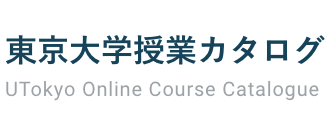過去(2024年度)の授業の情報です
学内のオンライン授業の情報漏洩防止のため,URLやアカウント、教室の記載は削除しております。
最終更新日:2025年10月17日
授業計画や教室は変更となる可能性があるため、必ずUTASで最新の情報を確認して下さい。
UTASにアクセスできない方は、担当教員または部局教務へお問い合わせ下さい。
最終更新日:2025年10月17日
授業計画や教室は変更となる可能性があるため、必ずUTASで最新の情報を確認して下さい。
UTASにアクセスできない方は、担当教員または部局教務へお問い合わせ下さい。
世界歴史と東アジアI(13)
Exploring the Past: Japanese Antiquarianism and Its Global Context
OVERVIEW
Antiquarianism, the love and study of old artifacts, has flourished in various periods and societies. Through reading scholarly texts and discussion, this class will explore the development of antiquarianism in the late Tokugawa period (late 18C – early 19C) and its influence on the modern disciplines of archaeology, history, art history, and museology. It also aims to put Japanese antiquarianism in the global context by comparing it with similar movements in other regions. As a way to supplement the reduced class hours, students will be required to visit a designated exhibition (“Modern Images of Ancient Clay Figures” at the National Museum of Modern Art). In addition to completing reading assignments and contribution to class discussions, students will be required to give one or two presentations and write a term paper. Through these activities, this course aims to provide students with an opportunity to read texts and observe the world critically.
COURSE OBJECTIVES
1) Deepen knowledge of history and culture.
2) Develop analytical skills through reading scholarly arguments and sources.
3) Give accurate presentations and write coherent essays.
Antiquarianism, the love and study of old artifacts, has flourished in various periods and societies. Through reading scholarly texts and discussion, this class will explore the development of antiquarianism in the late Tokugawa period (late 18C – early 19C) and its influence on the modern disciplines of archaeology, history, art history, and museology. It also aims to put Japanese antiquarianism in the global context by comparing it with similar movements in other regions. As a way to supplement the reduced class hours, students will be required to visit a designated exhibition (“Modern Images of Ancient Clay Figures” at the National Museum of Modern Art). In addition to completing reading assignments and contribution to class discussions, students will be required to give one or two presentations and write a term paper. Through these activities, this course aims to provide students with an opportunity to read texts and observe the world critically.
COURSE OBJECTIVES
1) Deepen knowledge of history and culture.
2) Develop analytical skills through reading scholarly arguments and sources.
3) Give accurate presentations and write coherent essays.
時間割/共通科目コード
コース名
教員
学期
時限
08F150813
FAS-FA4F08L3
世界歴史と東アジアI(13)
中井 真木
火曜4限
講義使用言語
英語
単位
2
実務経験のある教員による授業科目
NO
他学部履修
可
開講所属
教養学部
授業計画
Class schedule and readings are subject to change.
1. Introduction: what is antiquarianism? (online)
2. Antiquarianism and the modern world (Peter N. Miller and François Louis, "Antiquarianism and Intellectual Life in Europe and China”)
3. Antiquarianism in Tokugawa Japan 1 (François Lachaud, “The Scholar and the Unicorn: Antiquarians, Eccentrics, and Connoisseurs in Eighteenth-Century Japan”)
4. Antiquarianism in Tokugawa Japan 2 (Margarita Winkel, “Entertainment and Education: An Antiquarian Society in Edo, 1824–25”)
5. Antiquarianism in Meiji Japan (Suzuki Hiroyuki, “Ninagawa Noritane and Antiquarians in the Early Meiji Period”)
6. Antiquarianism and archaeology (Fumiko Ikawa‐Smith, “Co‐traditions in Japanese Archaeology”)
7. Mid-term summary discussion
8. Antiquarianism and artistic imagination (Discussion based on students' review of the exhibition “Modern Images of Ancient Clay Figures”)
[The topic and readings of the following sessions will be adjusted to students' interest)
9. Antiquarianism in comparison 1
10. Antiquarianism in comparison 2
11. Antiquarianism in comparison 3
12. Antiquarianism in comparison 4
13. Course summary
授業の方法
Class sessions will mainly consist of discussions and group work based on assigned readings. Towards the end of the semester, students will work on an essay project..
成績評価方法
Contribution to class discussion and class activities: 25%
Conscientious completion of homework assignments: 25%
Presentations: 20%
Term paper: 30%
教科書
Readings will be provided as PDFs or links to databases.
参考書
* Miller, Peter N., and François Louis. Antiquarianism and Intellectual Life in Europe and China, 1500-1800. University of Michigan Press, 2011.
* Schnapp, Alain, et.al, eds. World Antiquarianism: Comparative Perspectives. Getty Research Institute, 2013.
* Murray, Tim. From Antiquarian to Archaeologist : The History and Philosophy of Archaeology. Pen & Sword Archaeology, 2014.
* Miller, Peter N. History and Its Objects: Antiquarianism and Material Culture Since 1500. Cornell University Press, 2017.
* Suzuki Hiroyuki. Antiquarians of Nineteenth-Century Japan: The Archaeology of Things in the Late Tokugawa and Early Meiji Periods. Translated by Fukuoka Maki. Getty Research Institute, 2022.
履修上の注意
Students are expected to read the assigned readings thoroughly before class. They will be required to visit the designated exhibition by the designated date and submit a review. They also review class materials and engage in further readings for the essay project.





 学部後期課程
学部後期課程

 マイリストに追加
マイリストに追加
 マイリストから削除
マイリストから削除


